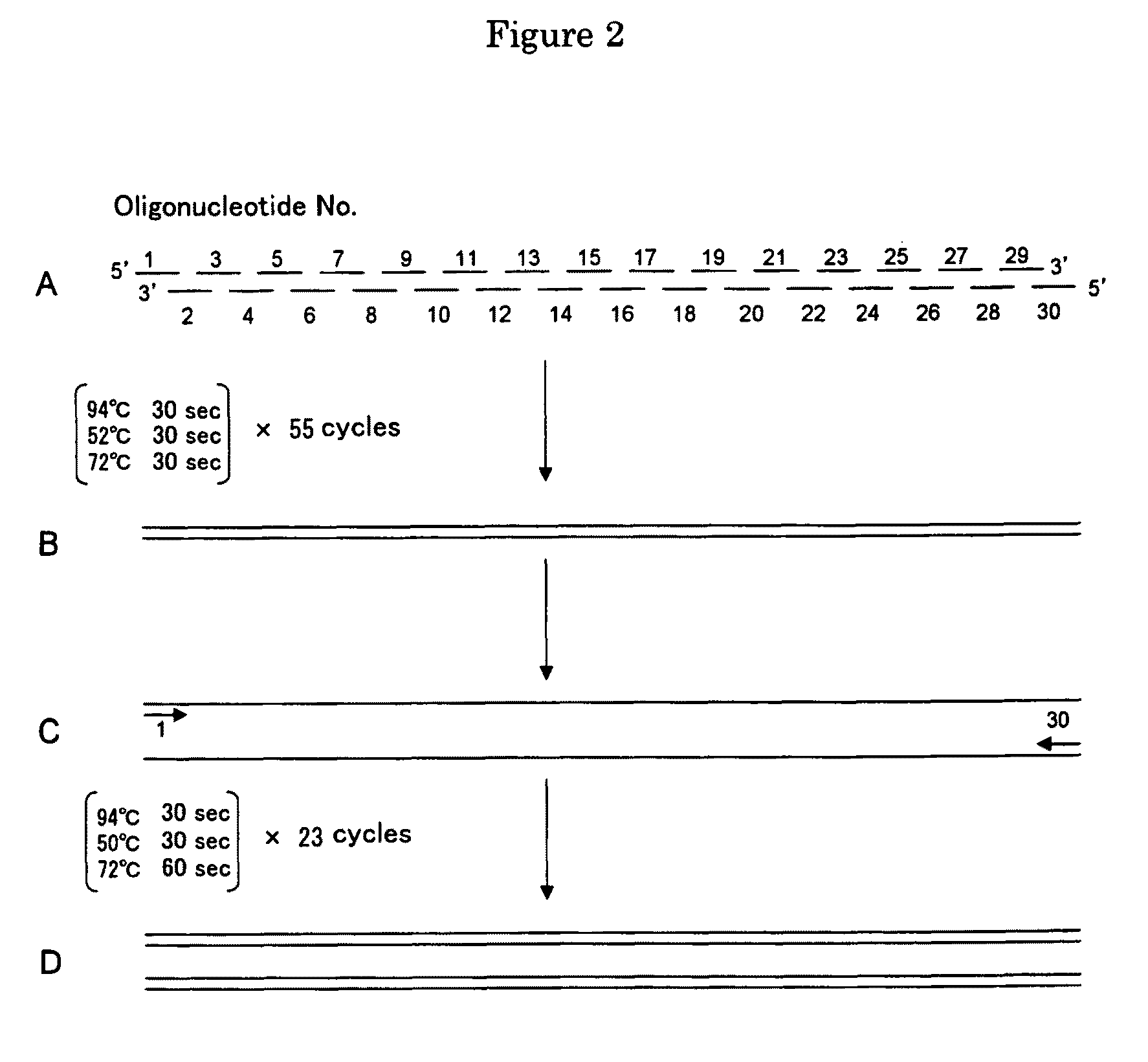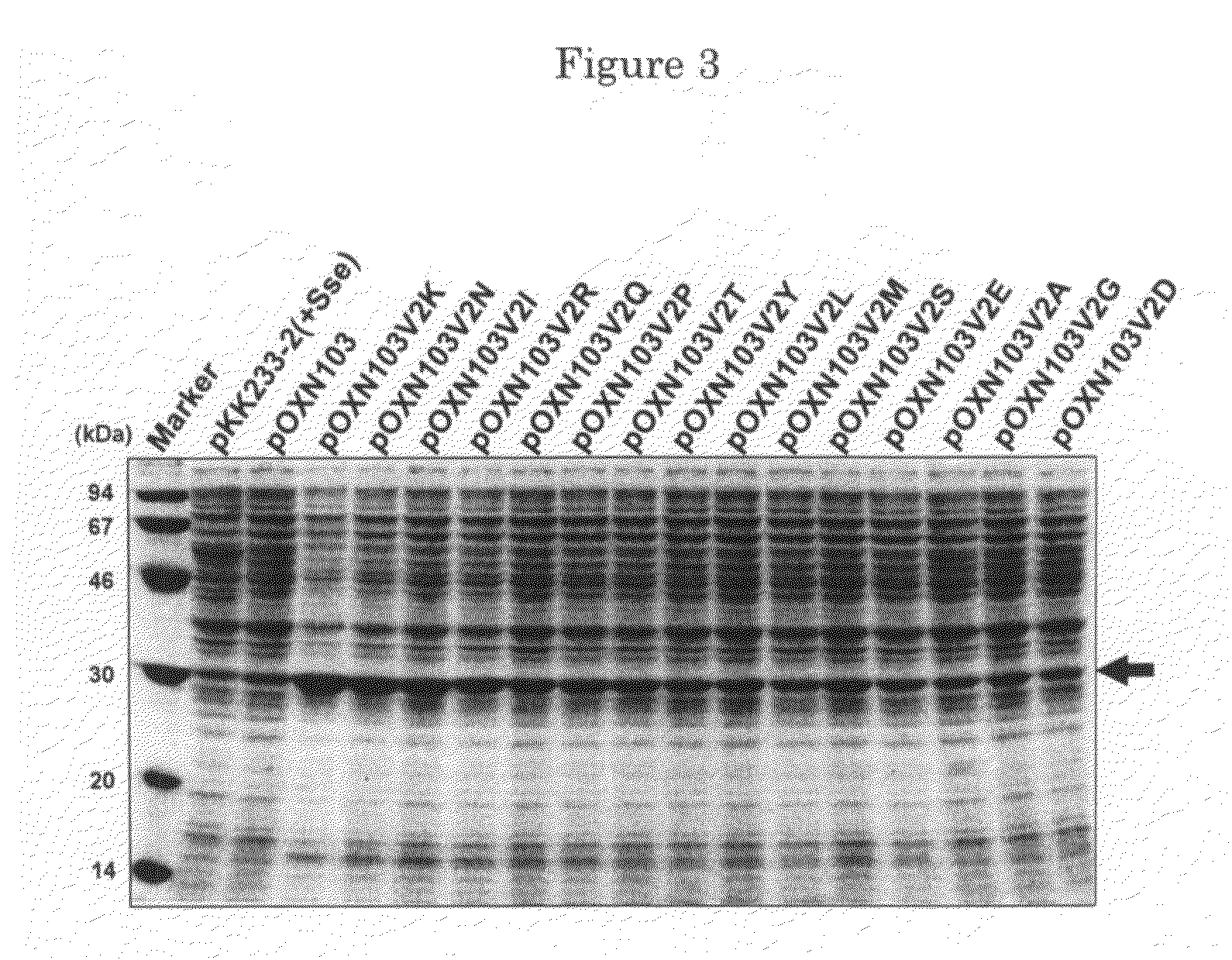Substitutional variants of hydroxynitrile lyase with high specific activity and methods of use
a lyase and hydroxynitrile technology, applied in the field of substitutional variants of hydroxynitrile lyase, can solve the problems of difficult prediction of behavior and expression level, inability to extract extremely small quantities of hydroxynitrile lyase, and inability to extract hydroxynitrile lyases from researches on corresponding homologous proteins, etc., to achieve the effect of improving hydroxynitrile lyas
- Summary
- Abstract
- Description
- Claims
- Application Information
AI Technical Summary
Benefits of technology
Problems solved by technology
Method used
Image
Examples
example 1
Obtainment of Plant Codon Wild-Type Hydroxynitrile Lyase Gene
(1) Preparation of Plant Codon Wild-Type Hydroxynitrile Lyase Gene by PCR
[0255]Based on the nucleotide sequence disclosed in GenBank accession number Z29091, a cassava (Manihot esculenta)-derived hydroxynitrile lyase gene represented by the sequence of SEQ ID NO: 2 was synthesized by PCR.
[0256]Specifically, 20 oligonucleotides designated F01-F10 and R01-R10 (SEQ ID NOS: 4-23) were designed and synthesized. Briefly, the 20 oligonucleotides F01-F10 and R01-R10 were designed so that they are complementary to a nucleotide sequence comprising the cassava (Manihot esculenta)-derived hydroxynitrile lyase gene disclosed in GenBank accession number Z29091 and its 5′ and 3′ untranslated regions (sense strand) and a complementary sequence thereto (antisense strand) (1,041 bp). In F01, 11 nucleotides (shown in italics) containing a BamHI recognition site are added to its 5′ end. In R01, 9 nucleotides (shown in italics) containing a Kp...
example 2
Preparation of Plant Codon Wild-Type Hydroxynitrile Lyase Expression Vectors
(1) Preparation of Plant Codon Wild-Type Hydroxynitrile Lyase Expression Vector (Based on pUC19)
[0266]An SD sequence was added to the nucleotide sequence of the plant codon wild-type hydroxynitrile lyase gene obtained in Example 1 to obtain a DNA fragment, which was then inserted at the PstI-BamHI site of pUC19 to thereby prepare a pUC19-based plant codon wild-type hydroxynitrile lyase expression vector pUMESD, as described below. First, a modified DNA fragment encoding the hydroxynitrile lyase was prepared by PCR. The reaction mixture for PCR was composed of 5 μl of Pwo 10× buffer, 5 μl of dNTP mix, 0.5 μl of Pwo DNA polymerase, 36.2 μl of distilled water, 1 μl of sense and antisense primers, and 1 μl of pUME as a template. PCR was performed as follows: 95° C. for 2 minutes for denaturation, 30 cycles of 94° C. for 30 sec, 50° C. for 30 sec and 72° C. for 2 minutes; and finally 72° C. for 10 minutes. The se...
example 3
Obtainment of E. coli Codon Wild-Type Hydroxynitrile Lyase Gene
(1) Design and Preparation of E. coli Codon Wild-Type Hydroxynitrile Lyase Gene by PCR
[0274]A hydroxynitrile lyase gene was newly designed, and some of its codons were converted to those codons frequently used in E. coli. Specifically, 30 oligonucleotides Nos. 1-30 (of these, 6 types consisting of 49 nt; 21 types consisting of 50 nt; 2 types consisting of 27 nt; and 1 type consisting of 48 nt) (SEQ ID NOS: 28-57) were designed and synthesized ultimately, and then prepared on 50 nmol scale. These 30 oligonucleotides were designed so that they overlap by 20 nt (FIG. 2).
[0275]
No. 1:(SEQ ID NO: 28)aaaagagttagatatcatttccaaaatggtgaccgcgcattttgtgctgNo. 2:(SEQ ID NO: 29)tccacgcgccatggcaaatggtatgaatcagcacaaaatgcgcggtcaccNo. 3:(SEQ ID NO: 30)ttgccatggcgcgtggatttggcataaactgaaaccggcgctggaacgcgNo. 4:(SEQ ID NO: 31)ccatatccagcgcggtcactttatggcccgcgcgttccagcgccggtttcNo. 5:(SEQ ID NO: 32)agtgaccgcgctggatatggcggcgagcggcattgatccgcgccagattg...
PUM
| Property | Measurement | Unit |
|---|---|---|
| temperature | aaaaa | aaaaa |
| temperature | aaaaa | aaaaa |
| temperature | aaaaa | aaaaa |
Abstract
Description
Claims
Application Information
 Login to View More
Login to View More - R&D
- Intellectual Property
- Life Sciences
- Materials
- Tech Scout
- Unparalleled Data Quality
- Higher Quality Content
- 60% Fewer Hallucinations
Browse by: Latest US Patents, China's latest patents, Technical Efficacy Thesaurus, Application Domain, Technology Topic, Popular Technical Reports.
© 2025 PatSnap. All rights reserved.Legal|Privacy policy|Modern Slavery Act Transparency Statement|Sitemap|About US| Contact US: help@patsnap.com



